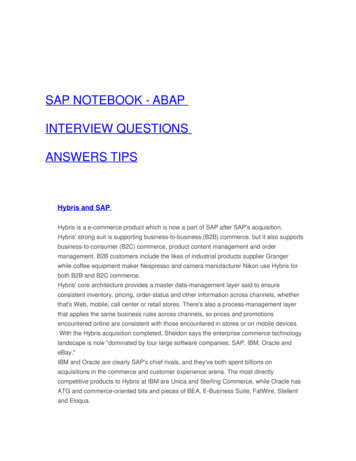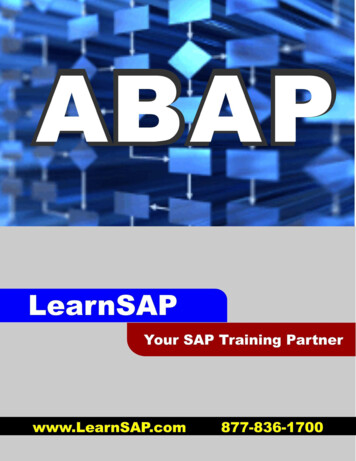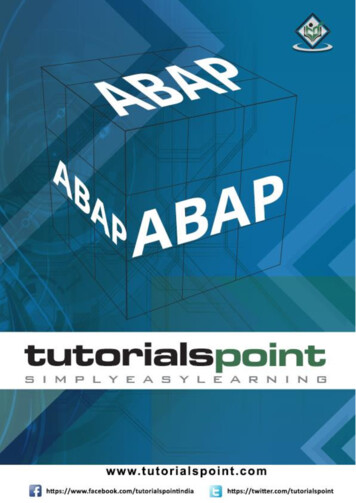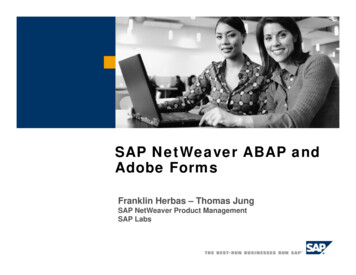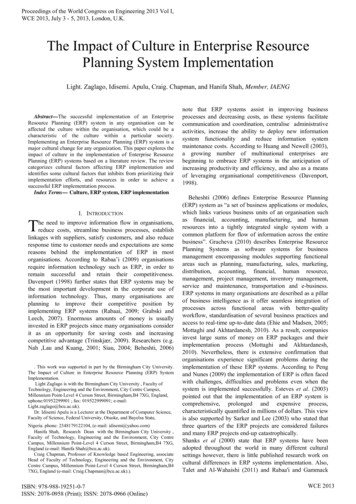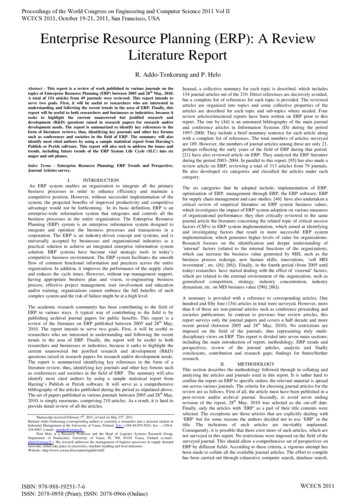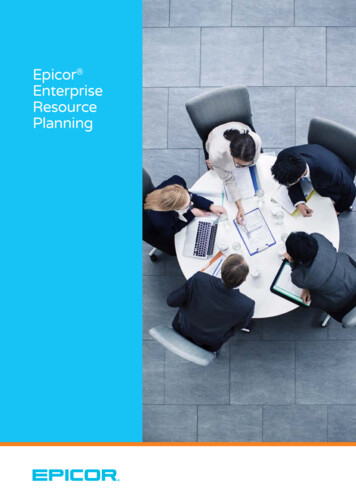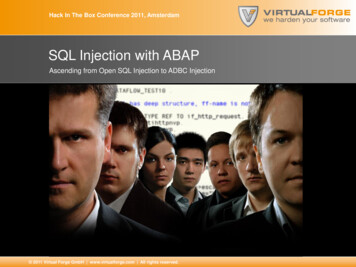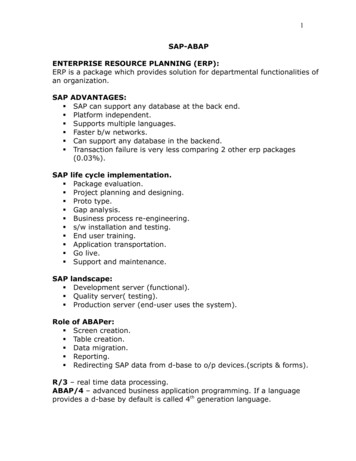
Transcription
1SAP-ABAPENTERPRISE RESOURCE PLANNING (ERP):ERP is a package which provides solution for departmental functionalities ofan organization.SAP ADVANTAGES:SAP can support any database at the back end.Platform independent.Supports multiple languages.Faster b/w networks.Can support any database in the backend.Transaction failure is very less comparing 2 other erp packages(0.03%).SAP life cycle implementation.Package evaluation.Project planning and designing.Proto type.Gap analysis.Business process re-engineering.s/w installation and testing.End user training.Application transportation.Go live.Support and maintenance.SAP landscape:Development server (functional).Quality server( testing).Production server (end-user uses the system).Role of ABAPer:Screen creation.Table creation.Data migration.Reporting.Redirecting SAP data from d-base to o/p devices.(scripts & forms).R/3 – real time data processing.ABAP/4 – advanced business application programming. If a languageprovides a d-base by default is called 4th generation language.
2R/3 ARCHITECTURE COMPONENTS:1. DISPATCHER - This component acts as an interface between the PL andAS. It receives user's request from PL and allocates a work area for eachrequest from the user.2. WORK PROCESS - This component allocates memory area for eachrequest received from dispatcher on a roll-in and roll-out basis. Once arequest is processed, the memory area is rolled out to allocate for nextrequest from dispatcher.3. DATABASE CONNECTIVITY- OPEN SQL - It receives each user's request in open SQL format(INSERT, UPDATE, DELETE, MODIFY) and converts them in native SQLformat (Database used at the back end).- NATIVE SQL - It checks for syntax errors in requests receivedand passes the request to database through gateway service.4. MESSAGE SERVICE - If there are any syntax errors in requests received,the Native SQL component uses message service to raise error messages forthe end user from the message pool. Message pool is a container of userdefined and pre-defined messages.5. GATEWAY SERVICE - If there is a distributed database at the back end,user's queries are redirected to appropriate database using gateway service.This component acts as an interface between AS and DL.WHAT IS CLIENT IN SAP? CLIENT is the topmost hierarchy in SAP database.Each functional module in SAP is assigned a client.The objects developed by ABAPer for each module is stored in apackage and request number and finally saved under a client numberassigned for the particular module.
3The development objects in SAP is divided into two types:REPOSITORY OBJECTS EXECUTABLE PROGRAMSINCLUDE PROGRAMSMODULE POOL PROGRAMSMESSAGE CLASSESSUBROUTINE POOLSFUNCTION GROUPSCLASS POOLSDATA DICTIONARY OBJECTS TABLESVIEWSDATA TYPESDOMAINSTYPE GROUPSSEARCH HELPSLOCK OBJECTSLOGGING INTO SAP:CLIENT : 800USERNAME : SAPUSERPASSWORD : VITLANG : EN (OPTIONAL)CREATING A PACKAGE IN SAP:PACKAGE is a folder created by ABAPer to store his own development objectsin SAP.Navigations to create a package:Enter 'SE21' Tcode in Command Prompt area of SAP EAsy Access Screen - Press Enter - Opens Package Builder Screen - Select Package Radiobutton- Specify Package Name starting with Z or Y - Click on Create pushbutton- Opens an interface - Enter Short Description for your package - SelectSoftware Component as HOME - Click on Save - OPens another interfaceto assign request number - Click on CREATE REQUEST - Opens interface- Enter short description - Click on Continue - A Request number is
4created and assigned for your package - Click on Continue - A package iscreated - Save - Come back.CREATING PROGRAMS IN SAP EDITOR:SE38 is the Tcode used to open ABAP editor, where we create source code.Navigations to create simple program in SE38 Editor:SE38 - Opens ABAP Editor Initial screen - Specify program name startingwith Z or Y - Select Source Code radio button - Click on Createpushbutton - Opens another interface - Enter short description forprogram - Select Program type as Executable Program - Click on Save - Specify Package Name - Assign request number - Click on continue - Opens ABAP Editor page.Characteristics of ABAP Program: ABAP is not case sensitive. ABAP is case sensitive only during comparison. Every ABAP statement should end with a period (full stop). CTRL S shortcut key is used to save ABAP codes in editor. CTRL F1 shortcut key is used to transform the screen intoCHANGE/DISPLAY mode. CTRL F2 shortcut key is used to check for syntax errors in sourcecode. CTRL F3 shortcut key is used to activate current program.ACTIVATION:This concept is used to make the current object to be accessible by otherobjects within the same client or different client or vice versa. F8 function key is used to execute the ABAP program (DirectProcessing).CTRL is used to comment the ABAP statement.CTRL is used to de comment the ABAP statement.VARIABLE DECLARATION IN ABAP:DATA is the statement used to declare variables in ABAP.Eg. code:DATA A TYPE I.A 100.WRITE A.
5In the above code, A is a variable of integer type. A is assigned a value'100'. WRITE statement is used to print out the value of A. The output of a program is printed in LPS (list-processing screen).The default value of an integer data type is '0'.The default value of a character data type is 'NULL'.An integer variable takes 11 character spaces in LPS screen to printout its value and the value is printed in right-justified manner.The first 10 character space is used to print the value and the 11thcharacter space is for sign (positive or negative).eg. code:DATA A TYPE I VALUE '-100'.WRITE A LEFT-JUSTIFIED.TYPE statement is used to assign data type for the variable declared.VALUE statement is used to assign initial value for the variable.
6ABAP GUIABAP screens can be created using the following two statements:1. PARAMETERS2. SELETION-SCREENThe following statements are used in common:1. PARAMETERS to create input boxes, checkboxes and radio buttons.2. SELECTION-SCREEN BEGIN OF LINE - END OF LINE. - This statement isused to create input fields in a same row.3. SELECTION-SCREEN COMMENT. - This statement is used to specify thepositions and label names for each input field declared using begin of line end of line.eg. codeSelection-screen begin of line.selection-screen comment 10(15) lb2 for field a.Parameters: a (10).selection-screen comment 50(15) lb3 for field b.parameters : b(10).selection-screen comment (15) lb4.parameters : c(10).selection-screen end of line.selection-screen pushbutton 10(10) LB1 user-command PB1.Initialization.lb1 'PRINT'.lb2 'enter A value'.lb3 'enter B value'.at SELECTION-SCREEN.
7case sy-ucomm.when 'PB1'.LEAVE TO LIST-PROCESSING.write :/ a, b .endcase.4. SELECTION-SCREEN POSITION.This statement is used to specify the position of input fields. There are twoattributes for specifying position using this statement. They are:POS LOWPOS HIGHEG.SELECTION-SCREENSELECTION-SCREENPARAMETERS A(10).SELECTION-SCREENPARAMETERS B(10).SELECTION-SCREENBEGIN OF LINE.POSITION POS LOW.POSITION POS HIGH.END OF LINE.5. SELECTION-SCREEN BEGIN OF SCREEN - END OF SCREEN.- This statement is used to create a screen in GUI. A screen number shouldbe specified for each user-defined screen. This screen can be called withinthe program using the following statement:CALL selection-SCREEN screen number .eg.SELECTION-SCREEN BEGIN OF SCREEN 100 TITLE T1.SELECTION-SCREEN BEGIN OF BLOCK B1.PARAMETERS : CH1 AS CHECKBOX,CH2 AS CHECKBOX,CH3 AS CHECKBOX.SELECTION-SCREEN END OF BLOCK B1.SELECTION-SCREEN BEGIN OF BLOCK B2.PARAMETERS : RB1 RADIOBUTTON GROUP A,RB2 RADIOBUTTON GROUP A,RB3 RADIOBUTTON GROUP A.SELECTION-SCREEN END OF BLOCK B2.
8SELECTION-SCREEN PUSHBUTTON /10(10) LB1 USER-COMMAND PB1.SELECTION-SCREEN END OF SCREEN 100.SELECTION-SCREEN BEGIN OF SCREEN 200 AS WINDOW TITLE T2.PARAMETERS : D(10), E(10), F(10).SELECTION-SCREEN END OF SCREEN 200.initialization.t1 'SELECT CHECKBOXES AND RADIOBUTTONS'.T2 'PARAMETERS'.at selection-screen.case sy-ucomm.WHEN 'PB1'.CALL SCREEN 200.ENDCASE.6. SELECTION-SCREEN BEGIN OF BLOCK - END OF BLOCK.This statement is used to create blocks within the screen area.7. SELECTION-SCREEN PUSHBUTTON. - This statement is used to createpushbuttons in GUI.SYNTAX:SELECTION-SCREEN PUSHBUTTON starting position (pushbutton length) label Variable USER-COMMAND pushbutton name .Whenever a pushbutton is created and executed, a system variable SYUCOMM holds the arguments for the pushbutton.INITIALIZATION and AT SELECTION-SCREEN are the selection-screenevents. Using these type of events, ABAP is called as event-drivenprogramming. Whenever the selection-screen programs are executed, theorder of execution of events will be:INITIALIZATION.AT SELECTION-SCREEN.START-OF-SELECTION.
9TOP-OF-PAGE.END-OF-PAGE.END-OF-SELECTION.EG. CODEPARAMETERS : A(10), B(10).SELECTION-SCREEN PUSHBUTTON /10(10) LB1 USER-COMMAND PB1.INITIALIZATION.LB1 'PRINT A'.AT SELECTION-SCREEN.CASE SY-UCOMM.WHEN 'PB1'.LEAVE TO LIST-PROCESSING.WRITE :/ A, B.ENDCASE.In the above code,AT SELECTION-SCREEN event is used to hold the event functionalities ofthe pushbuttons declared within the program. Whenever a pushbutton iscreated and executed, AT SELECTION-SCREEN event get triggered.INITIALIZATION event is used to declare initial display values for thepushbutton component in the selection-screen.SY-UCOMM system variable holds the arguments of pushbutton and passesthese arguments dynamically to the screen.LEAVE TO LIST-PROCESSING statement is used to print the statements inLPS, because these statements cannot be printed inside selection-screen.After executing the program, use 'BACK' statement in the command promptof LPS to come back to the selection-screen and then come back to theprogram.EG. CODE 2PARAMETERS : A(10), B(10).
10SELECTION-SCREEN PUSHBUTTON /10(10) LB1 USER-COMMAND PB1.selection-screen skip.SELECTION-SCREEN PUSHBUTTON /10(10) LB2 USER-COMMAND PB2.INITIALIZATION.LB1 'PRINT A'.lb2 'EXIT'.AT SELECTION-SCREEN.CASE SY-UCOMM.WHEN 'PB1'.LEAVE TO LIST-PROCESSING.WRITE :/ A, B.WHEN 'PB2'.LEAVE PROGRAM.ENDCASE.8. SELECTION-SCREEN SKIP.This statement is used to create a blank line within the selection-screencomponents.9. SELECTION-SCREEN ULINE.This statement is used to draw a horizontal line within the selection-screencomponent.10. SELECT-OPTIONS.EG. CODE:TABLES MARA.SELECT-OPTIONS STALIN FOR MARA-MTART.SELECT * FROM MARA WHERE MTART IN STALIN.WRITE :/ MARA-MTART.ENDSELECT.WRITE :/ STALIN-LOW, STALIN-HIGH, STALIN-SIGN, STALIN-OPTION.Whenever a range is created using SELECT-OPTIONS statement, SAP createsan internal table with the same variable name (STALIN in this case) in thebackground with the following fields:
11LOWHIGHSIGNOPTION11. SELECTION-SCREEN FUNCTION KEYS.The pushbuttons declared in the header part of the screen are referred to asFUNCTION KEYS. A user can be allowed to create only 5 function keys.SYNTAX:SELECTION-SCREEN FUNCTION KEY function key number .SSCRFIELDS is a predefined structure used to assign display values forfunction keys.TABLES SSCRFIELDS.PARAMETERS : A(10), .INITIALIZATION.SSCRFIELDS-FUNCTXT 01SSCRFIELDS-FUNCTXT 02SSCRFIELDS-FUNCTXT 03SSCRFIELDS-FUNCTXT 04SSCRFIELDS-FUNCTXT 05 AT SELECTION-SCREEN.CASE SY-UCOMM.WHEN 'FC02'.CALL TRANSACTION 'SE80'.'STALIN'.'JEGAN'.'SYED'.'DEEPA'.'KARTHIK'.
12WHEN 'FC01'.CALL TRANSACTION 'SE11'.WHEN 'FC03'.CALL TRANSACTION 'SE37'.WHEN 'FC04'.CALL TRANSACTION 'SE38'.WHEN 'FC05'.LEAVE PROGRAM.ENDCASE.When we create function keys, SAP automatically generates name for eachfunction key. The name of first function key is 'FC01' , the second one is'FC02', etc.So the name range for function keys start from FC01 - FC05.EG. PROGRAM TO CALL SELECTION-SCREEN WITH PUSHBUTTONSSELECTION-SCREEN BEGIN OF LINE.SELECTION-SCREEN COMMENT 10(15) LB1.PARAMETERS : A(10).SELECTION-SCREEN COMMENT 40(15) LB2.PARAMETERS : B(10).SELECTION-SCREEN END OF EENSELECTION-SCREENSELECTION-SCREENPUSHBUTTON 10(10) LB3 USER-COMMAND PB1.SKIP.PUSHBUTTON /10(10) LB5 USER-COMMAND PB3.SKIP.PUSHBUTTON /10(10) LB4 USER-COMMAND PB2.*SELECTION-SCREEN BEGIN OF SCREEN 200 AS WINDOW TITLE T2.SELECTION-SCREEN BEGIN OF BLOCK B1.
13PARAMETERS : CH1 AS CHECKBOX, CH2 AS CHECKBOX, CH3 ASCHECKBOX.SELECTION-SCREEN END OF BLOCK B1.SELECTION-SCREEN BEGIN OF BLOCK B2.PARAMETERS : RB1 RADIOBUTTON GROUP A,RB2 RADIOBUTTON GROUP A,RB3 RADIOBUTTON GROUP A.SELECTION-SCREEN END OF BLOCK B2.*SELECTION-SCREEN END OF SCREEN 200.INITIALIZATION.LB1 'ENTER A VALUE'.LB2 'ENTER B VALUE'.LB3 'DISPLAY'.LB4 'EXIT'.LB5 'CALL NEXT'.AT SELECTION-SCREEN.CASE SY-UCOMM.WHEN 'PB1'.LEAVE TO LIST-PROCESSING.WRITE : A, B.IF CH1 'X'.LEAVE TO LIST-PROCESSING.WRITE 'FIRST CHECKBOX IS SELECTED'.ENDIF.IF CH2 'X'.WRITE :/ 'SECOND CHECKBOX IS SELECTED'.ENDIF.IF CH3 'X'.WRITE :/ 'THIRD CHECKBOX IS SELECTED'.ENDIF.IF RB1 'X'.WRITE :/ 'FIRST RADIOBUTTON'.
14ELSEIF RB2 'X'.WRITE :/ 'SECOND RADIOBUTTON'.ELSEIF RB3 'X'.WRITE :/ 'THIRD RADIOBUTTON'.ENDIF.WHEN 'PB2'.LEAVE PROGRAM.WHEN 'PB3'.CALL SELECTION-SCREEN 200.ENDCASE.EN - LIBRARY HELP
15DATA DICTIONARYData dictionary objects are: TABLESVIEWSDATA ELEMENTSDOMAINSSEARCH HELPLOCK OBJECTTYPE GROUPSE11 is the Tcode used to access and create data dictionary objects.Some of the predefined tables to be used in common are:MARA - GENERAL MATERIAL DATA.MARC - PLANT DATA FOR MATERIAL.VBAK - SALES DOCUMENT : HEADER DATA.KNA1 - GENERAL DATA IN CUSTOMER MASTER.KNB1 KNC1 T001 LFA1 LFB1 LFC1 CREATING A TABLE:There are two ways to create a table:1. built-in type.2. using data elements and domains.SE11 - select DATABASE TABLE radiobutton - Specify table name startingwith Z or Y - Enter short description.Table creatio
SAP-ABAP ENTERPRISE RESOURCE PLANNING (ERP): ERP is a package which provides solution for departmental functionalities of an organization. SAP ADVANTAGES: SAP can support any database at the back end. Platform independent. Supports multiple languages. Faster b/w networks. Can support any database in the backend. Transaction failure is very less comparing 2 other erp packages (0.03%). SAP
